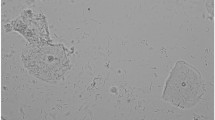Abstract
This study presents findings from a series of investigations on the presence of glycogenated epithelium in the male urinary tract and on the penile surface in order to assess the forensic value of the Lugol's method for the identification of vaginal cells. Direct smears obtained from the urethral opening, glans penis, and penile shaft, along with post-mortem samples of the fossa navicularis, and histological sections of the penis were examined. The presence of polygonal, glycogenated, Lugol-positive epithelium cells in the male urinary tract was found to be common. Our results suggest that these cells originate from the fossa navicularis. Because of the possibility of exfoliation of glycogenated male cells and transfer to the penile surface a Lugol-positive reaction in epithelial cells on penile swabs can no longer be assumed to prove the presence of vaginal cells.
Zusammenfassung
Wir untersuchten das Vorkommen glykogenhaltiger Epithelzellen im männlichen Harntrakt und an der Penisoberfläche, um die forensische Bedeutung der Lugol'schen Färbmethode für den Scheidenzellnachweis zu überprüfen. Das Untersuchungsmaterial bestand aus Abklatschpräparaten von Harnröhrenmündung, Glans Penis und Penisschaft sowie aus postmortalen Abstrichen aus der Fossa navicularis und histologischen Serienschnitten vom Penis. Polygonale, glykogenhaltige, Lugol-positive Epithelzellen waren regelmäßig im männlichen Harntrakt nachweisbar. Unsere Ergebnisse weisen darauf hin, daß diese Zellen aus der Fossa navicularis der Harnröhre stammen. Aufgrund einer möglichen Verschleppung abgeschilferter männlicher Epithelien an die Penisoberfläche, ist die Lugol'sche Färbemethode bei Penisabklatschpräparaten für den Scheidenzellnachweis ungeeignet.
Similar content being viewed by others
References
Bauer H (1937) Das Glykogen in den Plattenepithelien der Harn- und Geschlechtswege und seine forensische Bedeutung, untersucht an menschlichem und tierischem Material. MedDiss, Würzburg
Berg SP (1954) Methoden zum Nachweis von Genitalsekretspuren. Dtsch Z Gerichtl Med 42:605–613
Hausmann R, Pregler C, Schellmann B (1994) The value of the Lugol's iodine staining technique for the identification of vaginal cells. Int J Leg Med 106:298–301
Hayek H v (1969) Die Harnrohre des Mannes. Urethra masculina. In: Alken CE, Dix VW, Goodwin WE, Wildbolz E (Hrsg) Handbuch der Urologie. Springer, Berlin Heidelberg New York, p 324
Holzer F (1940) Scheidensekret. In: Neureiter F v, Pictrusky F, Schütt E (Hrsg) Handwörterbuch der Gerichtlichen Medizin und Naturwissenschaftlichen Kriminalistik. Springer, Berlin Heidelberg New York, p 633
Merkel H (1924) Über den Glykogengehalt des Scheidenepithels, seine diagnostische Bedeutung und deren kritische Bewertung. Z Ges Gerichtl Med 4:1–8
Popielski B (1949) A study of menstrual blood traces. Bulletin de l'Académie Polonaise des Sciences et des Lettres, Classe de Médecine, pp pp275–284
Randall B, Riis RE (1985) Penile glycogenated epithelial cells as an indicator of recent vaginal intercourse.Am J Clin Pathol 84:524–526
Romeis B (1968) Kohlenhydrate. In: Romeis B (Hrsg) Mikroskopische Technik. Oldenbourg, München Wien, pp 186–187, pp 269–273
Rothwell TJ, Harvey KJ (1978) The limitation of the Lugol's iodine staining technique for the identification of vaginal epithelial cells. J Forensic Sci 18:181–184
Schaidt G (1975) Spurenuntersuchung und andere rechtsmedizinische Technik: Scheidensekret. In: Mueller B (Hrsg) Gerichtliche Medizin, Bd I. Springer, Berlin Heidelberg New York, pp 135–136
Soost HJ, Baur S (1990) Zytologie maligner Tumoren und ihrer Vorstufen. Schwierig zu beurteilende zytologische Befunde. In: Soost HJ, Baur S (Hrsg) Gynäkologische Zytodiagnostik. Thieme, Stuttgart, New York, pp 190
Thomas F, v Hecke W (1963) The demonstration of recent sexual intercourse in the male by Lugol method. Med Sci Law 3:169:171
Tröger HD, Eisenmenger W (1977) Eine Methode zum Nachweis von Scheidenepithelien. Beitr Gerichtl Med 35:109–111
Wiegmann H (1910) Über den Glykogengehalt der Scheidenepithelien und seine diagnostische Bedeutung. Med-Diss, München
Author information
Authors and Affiliations
Rights and permissions
About this article
Cite this article
Hausmann, R., Schellmann, B. Forensic value of the Lugol's staining method: further studies on glycogenated epithelium in the male urinary tract. Int J Leg Med 107, 147–151 (1994). https://doi.org/10.1007/BF01225602
Received:
Revised:
Issue Date:
DOI: https://doi.org/10.1007/BF01225602




